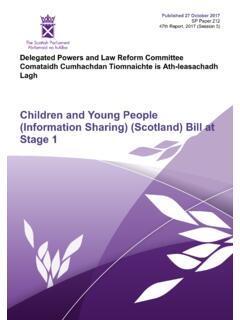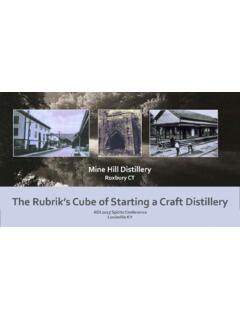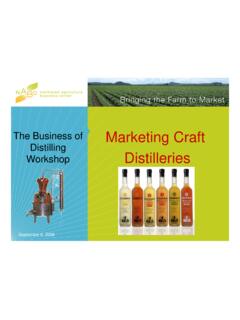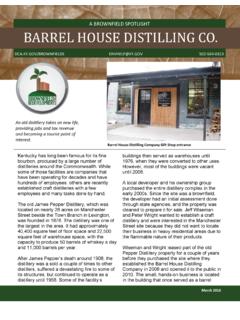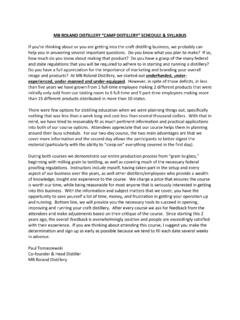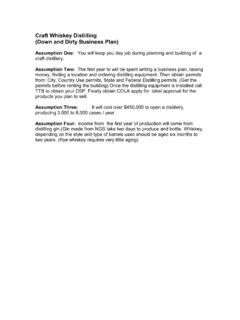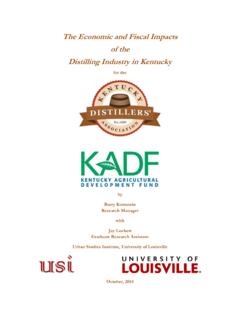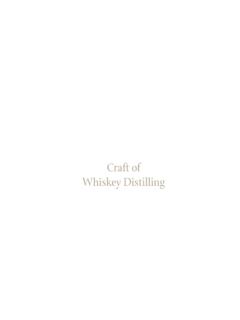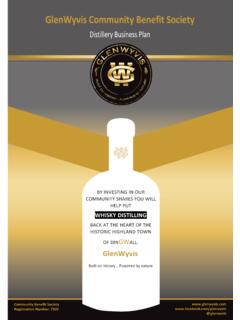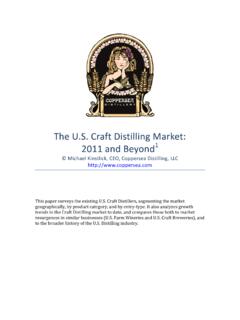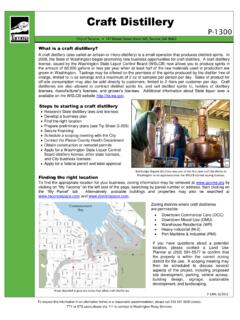Transcription of Brewing and distilling in Scotland - economic facts and ...
1 11 October 2018SB 18-64 SPICe BriefingP ipear-ullachaidh SPICeBrewing and distilling in Scotland - economic facts and figuresAlison O'ConnorScotland's Brewing and distillingsectors play a vital role in theScottish economy, permeatingmany facets of Scottish paper presents economicfacts and figures about Scotland 'sbrewing and distilling sectors, withthe objective of aiding policyscrutiny and developments inthese sectors. Topics coveredinclude: business base profile,turnover, employment, GVA, trade,and links with other Summary_____4 Introduction_____7 Alcohol market trends_____8 Spirits.
2 A growing industry_____8A Brewing industry_____10 Report structure_____10 Scotland 's spirits_____12 business base_____12 Turnover and size_____13 Employment_____15 Income_____16 Trade_____17 Gin in focus_____17 Defining what is a Scottish gin_____18 Gin-tastic variety_____18 Whisky in focus_____20 Whisky duty_____21 Whisky exports_____22 Geographical Indication_____23 Whisky galore_____23 Summary infographic distilling_____25 Scotland 's brewing_____26 business base_____26 Turnover and size_____27 Employment_____29 Income_____30 Production and trade_____32 Beer in focus_____33 Craft beer: a definition_____33 Beer duty_____34 Flavour of Scotland 's brewers_____35 Summary infographic brewing_____37 Links with other industries_____38 Agriculture_____38 Brewing and distilling in Scotland - economic facts and figures, SB 18-642 Malting_____38 Tourism_____39 Policy considerations_____41 Bibliography_____42 Brewing and distilling in Scotland - economic facts and figures, SB 18-643 Executive SummaryScotland's Brewing and distilling sectors play a vital role in the Scottish economy.
3 Manydistillers and brewers are based in rural communities. This is not only important for directjobs but also indirectly through generation of tourism, linkages to agriculture, and widersupply chain impacts. Many firms in both sectors are at the forefront of product innovationto cater for ever changing consumer trends. Food and drink is an integral component ofhow "brand Scotland " is promoted globally. Exported brewery and distillery products helpto sell Scotland to the , alcoholic drinks volume sales have been declining and are expected to stagnatefurther over coming years.
4 Continued growth in spirits, benefited by the cocktail culture, iscounterbalanced by decline in ready-to-drink premixes and stagnation in beer, cider/perryand wine. The healthy lifestyle trend has also impacted on alcohol sales manifesting itselfin several ways, including increased use of natural botanicals as gin ingredients, growth innatural wines, increased use of fruit flavours in cider, and an increase in low/no-alcoholbeers, wines and the Scottish spiritThe UK's distilling sector is going through an unprecedented boom. The majority of growthin distilling enterprises has been in England, driven by gin production, which hassurpassed Scotland in terms of UK share of distilleries since 2010.
5 Though in terms ofrevenue share and employment size-band, Scotland is still dominant. It shouldn't besurprising that Scotland is leading the way as it is the whisky capital of the world withhundreds of years of distillery expertise. Here are some key points about Scotland 'sdistilling business base. Given that some of the large Scottish distilling enterprises produce numerous brandsof spirits at different sites, the distinction between enterprises and local units becomesimportant. In 2018, Scotland had 245 distilling related business local units.
6 This figurerepresents growth of 69% in the business base since 2010. Much of this growth hasbeen over the last two years. The two years to 2018 alone saw an additional 55 localunits recorded. Twenty-two of Scotland 's 32 local authorities have a distilling business presence - upfrom 15 local authorities in 2010. The Moray area has the highest intensity of distillingrelated firms, with almost a quarter of Scottish distilling activity based there. Average turnover across all Scottish distilleries was approximately million in2018, compared to average turnover of 673,000 for all businesses in the Scottisheconomy.
7 Nine in ten distilling jobs in Britain are based in Scotland . Employment levels in theindustry have been relatively stable, varying between 7,000 to 8,000 over the lasteight spirits industry contributes approximately 3% to total Scottish GDP. In the 18 years ofavailable data, the contribution of the sector to GDP has averaged and peaked of total GDP in 2013. GVA at basic prices for Scotland 's 'spirits and wines' industrywas billion in 2015. This was down from a record high of 4 billion in 2013. The twomost recent years of available data (2014-15) show an emerging downward and distilling in Scotland - economic facts and figures, SB 18-644 Spirit duty is a tax on producing and selling spirits, with rates set by the UK current rate per litre of pure alcohol is In real terms the level of excise duty onspirits has fallen by 50% since 1978/9.
8 Commentators argue that there is a strong case forreform of alcohol duties as the current system is not well targeted at heavy drinkers andhas indefensible are over 110 Scottish gins, and over 60 distilleries currently producing gin withinScotland. Three of the world's bestselling gins: Hendrick s, Gordon s and Tanqueray,are all made in Scotland . The way gin has interjected in the homeland of whiskyshould not be surprising. Increasingly Scotland whisky distillers are looking to ginbecause it's quicker and easier to make, and gives them a faster return when waitingfor whisky to mature.
9 It is estimated that some 70-80% of UK produced gin comesfrom Scotland . Gin's popularity has seen an onslaught of new 'Scottish' brands hit themarket. This has resulted in concerns from industry experts about what is truly aScottish is home to 128 malt and grain distilleries, making it the greatestconcentration of whisky producers in the world. While many countries in the worldproduce whisky, only Scotland can make Scotch'. The majority of scotch whisky isconsumed as blended scotch whisky. In 2017, the value of scotch whisky exportsreached a record billion.
10 To put this into perspective, total expenditure byinternational visitors to Scotland in 2017 was billion. Scotland 's national drinkaccounts for 20% of all UK food and drink 's brewingGlobally, beer consumption has been falling for decades. However, this has not dampenedthe significant brewery start-up rate, responding to consumers choosing to drink moreexpensive, specialised beers. Scotland 's craft breweries have flourished over recent yearswith a plethora of new breweries entering the in 1840, Scotland boasted 280 breweries. However, by 1910 this had been reducedto 92 and a continuous decline eventually reduced that number to just 11 by 1970.


